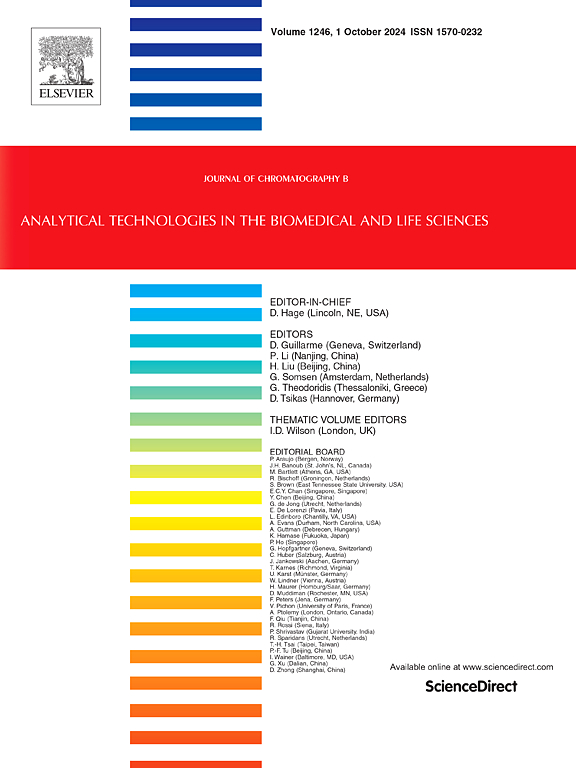Stability-indicating HPLC analysis of Azilsartan Medoxomil potassium: A QbD-based method development and validation
IF 2.8
3区 医学
Q2 BIOCHEMICAL RESEARCH METHODS
引用次数: 0
Abstract
Developing robust analytical methods for Azilsartan Medoxomil Potassium (AZM), a potent angiotensin II receptor antagonist, is essential due to its instability and limited aqueous solubility. This study aimed to establish and optimize a high-performance liquid chromatography (HPLC) method for the accurate and stability-indicating quantification of AZM and its impurities in the active pharmaceutical ingredient (API) and formulated drug products. Using an Analytical Quality by Design (A-QbD) framework, method parameters were optimized through a Central Composite Design (CCD), focusing on variables such as acetonitrile concentration, buffer pH, and flow rate to achieve desirable tailing factors and retention times. The validated method demonstrated high accuracy, precision, and sensitivity, with a linear response range of 10–50 μg/mL and limits of detection and quantification as low as 0.00607 and 0.01841 ng/mL, respectively. Forced degradation studies confirmed the method's selectivity and stability-indicating capabilities by identifying distinct degradation products under various stress conditions, including acidic, basic, oxidative, and photolytic environments. The validated HPLC method was successfully applied to a commercial AZM formulation, yielding assay values within acceptable limits for quality control. This study provides a reliable and robust analytical method that ensures the quality and stability of AZM throughout its lifecycle.

阿兹沙坦美多索米钾稳定性指示高效液相色谱分析:基于qbd的方法建立与验证
阿兹沙坦美多索米钾(AZM)是一种有效的血管紧张素II受体拮抗剂,由于其不稳定性和有限的水溶性,开发可靠的分析方法至关重要。本研究旨在建立并优化一种高效液相色谱(HPLC)方法,用于准确、稳定地定量测定原料药和制剂中AZM及其杂质。采用分析质量设计(a - qbd)框架,通过中心复合设计(CCD)对方法参数进行优化,重点考虑乙腈浓度、缓冲液pH和流速等变量,以获得理想的尾矿因子和保留时间。该方法具有较高的准确度、精密度和灵敏度,线性响应范围为10 ~ 50 μg/mL,检出限和定量限分别低至0.00607和0.01841 ng/mL。强制降解研究证实了该方法的选择性和稳定性指示能力,通过识别不同胁迫条件下的不同降解产物,包括酸性、碱性、氧化和光解环境。经验证的高效液相色谱法成功地应用于商业AZM制剂,所得测定值在可接受的质量控制范围内。本研究提供了一种可靠、稳健的分析方法,保证了AZM在整个生命周期内的质量和稳定性。
本文章由计算机程序翻译,如有差异,请以英文原文为准。
求助全文
约1分钟内获得全文
求助全文
来源期刊

Journal of Chromatography B
医学-分析化学
CiteScore
5.60
自引率
3.30%
发文量
306
审稿时长
44 days
期刊介绍:
The Journal of Chromatography B publishes papers on developments in separation science relevant to biology and biomedical research including both fundamental advances and applications. Analytical techniques which may be considered include the various facets of chromatography, electrophoresis and related methods, affinity and immunoaffinity-based methodologies, hyphenated and other multi-dimensional techniques, and microanalytical approaches. The journal also considers articles reporting developments in sample preparation, detection techniques including mass spectrometry, and data handling and analysis.
Developments related to preparative separations for the isolation and purification of components of biological systems may be published, including chromatographic and electrophoretic methods, affinity separations, field flow fractionation and other preparative approaches.
Applications to the analysis of biological systems and samples will be considered when the analytical science contains a significant element of novelty, e.g. a new approach to the separation of a compound, novel combination of analytical techniques, or significantly improved analytical performance.
 求助内容:
求助内容: 应助结果提醒方式:
应助结果提醒方式:


